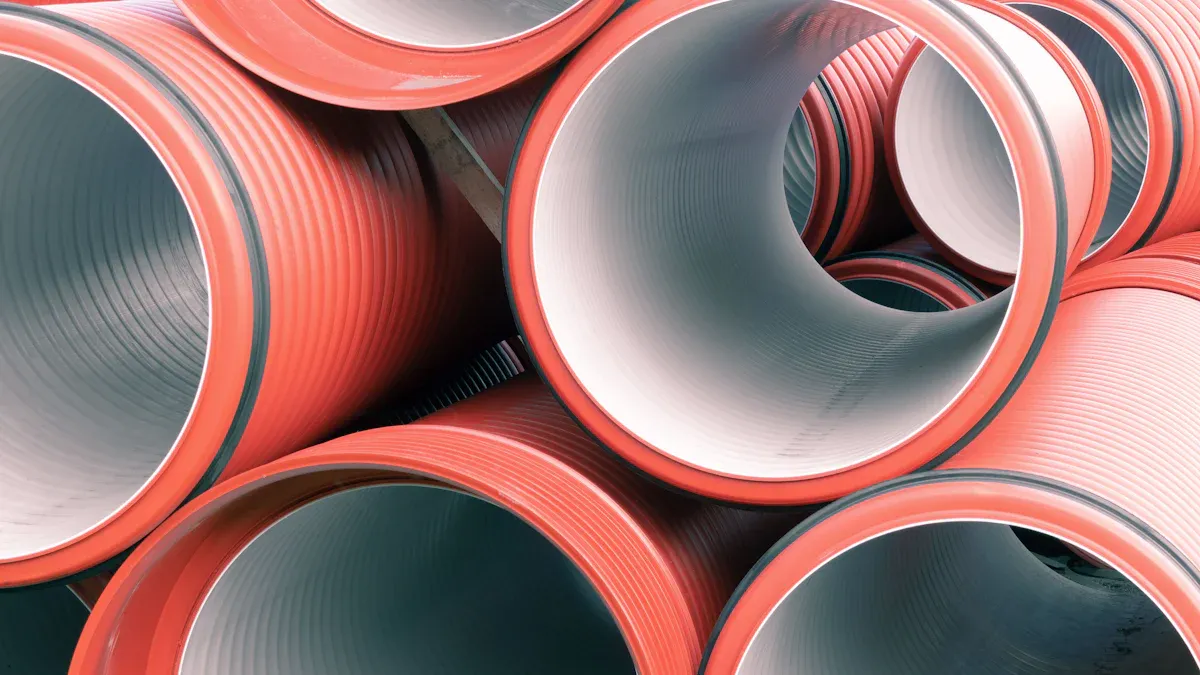A Buyer's Guide to Choosing the Best High-Quality Nitinol Tubing

Choosing high-quality Nitinol tubing ensures it performs effectively and has a long lifespan. The quality of the tubing significantly impacts the safety and functionality of products, particularly in the medical field. For example:
High-quality Nitinol tubing adheres to essential quality control standards.
Superior materials enhance the strength and performance of products.
Excellent tubing maintains its integrity and durability over time.
Understanding your requirements and the properties of Nitinol is crucial. This knowledge aids in selecting tubing that meets safety, physical, and environmental criteria for enduring success.
Key Takeaways
Pick good Nitinol tubing for safe and strong use in tools.
Learn about Nitinol's features, like shape memory and flexibility, to choose the right one.
Look for certifications like ISO 13485 to ensure safety and quality.
Think about your project needs, like weather and strength, before choosing.
Buy from trusted sellers who offer quality and custom options for tubing.
Understanding High-Quality Nitinol Tubing

Key Properties of Nitinol
Nitinol is a mix of nickel and titanium metals. It has special abilities that make it stand out. One key feature is shape memory. This means it can bend and return to its original shape. This makes it perfect for important uses. Another feature is superelasticity. This lets nitinol handle heavy strain without breaking. These traits are vital for medical tools like stents and catheters. They need to be both flexible and dependable.
Nitinol is also strong and durable. Its strength and stretchiness are tested carefully. It has a density between 6.45 g/cm³ and 6.75 g/cm³. This makes it lightweight for medical devices. Its heat conduction ranges from 10-20 W/mK. This helps it handle moderate heat, which is useful in many ways.
Benefits of High-Quality Nitinol Tubing
Good nitinol tubing works well and lasts long. It is very flexible and strong, making it great for surgery tools. For example, nitinol parts in blood vessel tools can handle 400 million pressure cycles. This ensures they stay safe and effective for a long time.
High-quality nitinol is also safe for the body. It doesn’t rust, even in tough conditions. This keeps it working longer and lowers the chance of failure. Its strength helps it survive harsh environments. This makes it useful in planes and ships too.
Common Applications of Nitinol Tubing
Nitinol is used in many industries because it is so versatile. In medicine, it is found in stents, catheters, and other tools. Its shape memory and body-safe features make it reliable for saving lives.
In airplanes, nitinol is light and doesn’t rust, making it great for key parts. It also handles extreme heat, so it works well in tough conditions. In the ocean, nitinol’s strength and rust resistance help underwater tools last longer.
Nitinol tubing is strong and flexible. It keeps improving industries and is valuable for many uses.
Evaluating Application Needs
Environmental and Operating Conditions
Think about where the nitinol tubing will be used. Nitinol can handle tough conditions like heat and moisture. This makes it great for hard environments. For example, stents and catheters work inside the body. They face moisture and changing temperatures. Nitinol’s shape memory helps it work well in these situations.
In factories, tubing must handle repeated stress. Studies show TM-1 tubing breaks more easily than TM-2. TM-2 uses purer materials, so it lasts longer. Knowing these details helps you pick the right tubing for your needs.
Physical and Performance Requirements
The tubing’s features should match what you need it for. Medical tools need precise sizes to work safely. Even small size errors can cause problems. Smooth surfaces are also important for medical use. They make the tubing safer for the body.
You can customize tubing to fit your needs. Change its thickness, size, or material to match your project. Suppliers can help you adjust these features. Whether for medical tools or airplanes, matching tubing to your needs ensures good results.
Compliance with Industry Standards
Nitinol tubing must meet safety rules for your industry. These rules make sure the tubing is safe and works well. Medical-grade tubing must follow strict health standards. For example, stents must be safe for the body to avoid issues.
In planes and cars, tubing must handle extreme conditions. Suppliers should give proof that their tubing meets these rules. Choosing certified tubing lowers risks and ensures it works reliably.
Types of Nitinol Tubing

Seamless vs. Welded Tubing
When picking nitinol tubing, know the difference between seamless and welded types. Seamless tubing is made by extrusion, giving it better strength and evenness. This makes it great for high-pressure and hot environments, like medical tools or factories. Welded tubing is made by rolling metal sheets and welding the edges. It costs less but is not as strong as seamless tubing. For jobs needing top safety and durability, seamless tubing is the best choice.
Tip: Seamless tubing works well for medical tools like stents because it handles stress reliably.
Thin-Walled vs. Thick-Walled Tubing
The thickness of nitinol tubing walls affects how it works. Thin-walled tubing is light and bends easily, making it perfect for precise jobs like medical tools. Thick-walled tubing is stronger and lasts longer, which is good for tough environments or heavy use.
Material | Tensile Strength Range (MPa) | Special Features |
|---|---|---|
Nitinol Tubing | 500–900 | Shape memory and superelasticity |
Stainless Steel | 600–1100+ | Works well in many conditions |
Titanium Alloys | 900–1200 | Strong but lightweight |
Thin-walled tubing is often used in medical tools because it fits delicate areas. Thick-walled tubing is better for industrial jobs needing extra strength.
Custom vs. Standard Tubing Options
Custom nitinol tubing lets you change size, material, and how it’s made to fit your needs. For example, TM-1 tubing lasts longer and has a smoother surface than TM-2. TM-1 tubing can last two to three times longer, making it better for tough tasks.
Standard tubing is easier to find but may not perform as well as custom tubing. If your project needs exact details or extra strength, custom tubing is a smart choice.
Note: Custom tubing is especially useful for medical tools where safety matters most.
Step-by-Step Selection Guide for Nitinol Tubing
Define Your Application Requirements
First, figure out what your project needs. Think about where the nitinol tubing will be used. For example, medical tools like stents face moisture, heat, and movement. Industrial uses may need tubing to handle high heat or heavy stress. Tests like fatigue testing check if the tubing can handle these conditions. Things like oxygen and carbon levels affect how long it lasts.
Plan tests early to ensure the tubing fits your needs. High-purity nitinol works better for long-lasting tasks. It’s great for jobs needing strong and reliable materials. Knowing your needs early saves money and ensures safety.
Assess Material Properties and Grades
Check the material features of nitinol tubing to pick the best one. Look at its shape memory and superelasticity, which are important for medical tools. Tests like DSC and BFR measure these traits. Good tubing should meet ASTM F 2063 standards for quality and purity.
Durability is also very important. For instance, stent tubing must handle 400 million pressure cycles without breaking. High-purity nitinol is better for tough jobs like this. Always ask your supplier for test results to confirm the tubing’s quality and if it fits your needs.
Compare Tubing Types and Features
Pick the right tubing by comparing seamless and welded types. Seamless tubing is stronger and more even, making it good for medical tools. Welded tubing costs less but isn’t as durable.
Wall thickness matters too. Thin-walled tubing is light and bends easily, great for precise tools. Thick-walled tubing is stronger and better for heavy-duty jobs. If unsure, ask experts or manufacturers for advice. Testing samples in real situations can help you decide.
Tip: Always choose quality over cost for important nitinol tubing uses.
Work with Trusted Suppliers and Experts
Start by finding trusted suppliers for nitinol tubing. Good suppliers provide high-quality tubing that fits your needs. They also give important certifications and test results to prove safety.
Choose suppliers with experience in making nitinol tubing. Check if they focus on uses like medical tools or industrial parts. Skilled suppliers know nitinol’s special traits, like shape memory and flexibility. They can help you pick tubing that works for your project.
Ask about how the tubing is made. Strong nitinol tubing often uses seamless extrusion. This process makes tubing even and durable, perfect for medical tools. Suppliers should also offer custom options. For example, they can change the thickness or size to match your needs.
Talking to experts can also help you decide. Professionals know the latest nitinol technology. They can suggest tubing that balances strength, cost, and performance. Experts also explain safety rules for your industry, so the tubing meets all standards.
Always check if your supplier is reliable. Look for certifications like ISO 13485 for medical tubing or ASTM for industrial use. These prove the tubing meets strict quality rules. By working with trusted suppliers and experts, you’ll get tubing that works well in any situation.
Common Mistakes to Avoid When Choosing Nitinol Tubing
Forgetting Specific Project Needs
Always think about what your project requires. Each job is different. For example, medical tools like stents need exact sizes and smooth surfaces. These details keep them safe and working well. Ignoring this can cause problems or failures.
Also, consider where the tubing will be used. Will it face heat, moisture, or stress? Nitinol’s shape memory works well in tough spots, but only if it fits the job. Know your needs before picking tubing.
Skipping Certification Checks
Make sure the tubing meets safety rules. Certified tubing is safer and more reliable. This is very important for medical tools. For example, medical tubing must follow strict health rules to protect patients.
Ask suppliers for certifications like ISO 13485 or ASTM. These prove the tubing is high quality and safe. Using uncertified tubing might seem faster, but it can cause big problems later. Always check that the tubing meets your industry’s rules.
Picking Based Only on Price
Choosing cheap tubing can cause trouble. Good tubing depends on strong materials and careful making. Cheap tubing often has flaws that lead to damage and failure.
Better nitinol costs more but lasts longer and works better. For example, stents need tubing that handles millions of pressure cycles without breaking. Spending more on good tubing lowers risks and helps in the long run. Balance cost with safety and quality.
Not Checking If the Supplier Is Trustworthy
Picking a good supplier for nitinol tubing is very important. If you don’t check if they are trustworthy, you might buy tubing that doesn’t work well. This can cause problems, safety risks, or even ruin your project.
Start by learning about the supplier’s reputation. Look for reviews or stories from other buyers. A good supplier will have proof of making quality nitinol tubing. See if they focus on your industry, like medical tools or factories. Experts in your field will better understand what you need.
Ask for certifications and proof of quality. Reliable suppliers will show that their tubing meets safety rules. For example, medical tubing should follow ISO 13485 to be safe for patients. Industrial tubing should meet ASTM rules for strength and durability. Without these, you can’t be sure the tubing is good or safe.
If you can, visit the supplier’s factory. Watching how they make tubing can show if they care about quality. Good suppliers test their products carefully and share how they make them.
Talk directly to the supplier. Ask about the tubing’s features, like shape memory and strength. A trustworthy supplier will give clear answers and help you pick the right tubing.
By checking the supplier’s trustworthiness, you make sure the tubing is safe and works well. This step saves money and helps your project succeed.
Picking good nitinol tubing helps your project work safely and well. It’s important to match the tubing to your specific needs. This applies to both medical tools and industrial jobs. Pay attention to key things like temperature, size, and surface smoothness. These details make sure the tubing is strong and reliable. The table below shows important factors to check when buying:
Important Factors for Buying | Why They Matter |
|---|---|
Temperature (Af) | Makes sure it works for your project |
Size | Helps it fit and work correctly |
Surface Smoothness | Improves safety and stops rust |
Certifications | Proves it’s high quality and follows rules |
Best Buying Tips | Testing ensures it’s safe and dependable |
Talking to experts and trusted sellers can guide you through these steps. Always choose quality over low price to avoid problems later. By making smart choices, you can use nitinol’s special shape memory to build strong and useful products.
FAQ
What makes nitinol tubing special?
Nitinol tubing is unique because it can remember its shape. It bends but returns to its original form. It also handles heavy stress without breaking. These traits make it great for medical tools and tough jobs.
How is nitinol tubing kept safe for medical tools?
Safety comes from using tubing that follows strict rules like ISO 13485. Good nitinol doesn’t rust and works well under pressure. This makes it safe for stents, catheters, and other medical devices.
Can nitinol tubing be made for specific needs?
Yes, nitinol tubing can be changed to fit your needs. You can pick its size, thickness, and material features. This helps it work well for medical or industrial projects.
Why does quality matter when picking nitinol tubing?
Quality makes sure the tubing works well and lasts longer. Strong nitinol keeps its shape memory and meets safety rules. This is very important for medical tools and precise tasks.
Which industries use nitinol tubing the most?
The medical field uses nitinol a lot because it’s flexible and safe for the body. It’s also used in airplanes and ships for its strength, rust resistance, and ability to handle tough conditions.
See Also
Choosing the Ideal Nitinol Tubing Supplier for You
Comprehensive Process for Selecting Suitable Nitinol Tubing
Complete Handbook for Nitinol Parts and Production Methods
The Process of Creating Nitinol Tubing for Healthcare
Detailed Instructions for Making Nitinol Microtubing in Neuroscience

